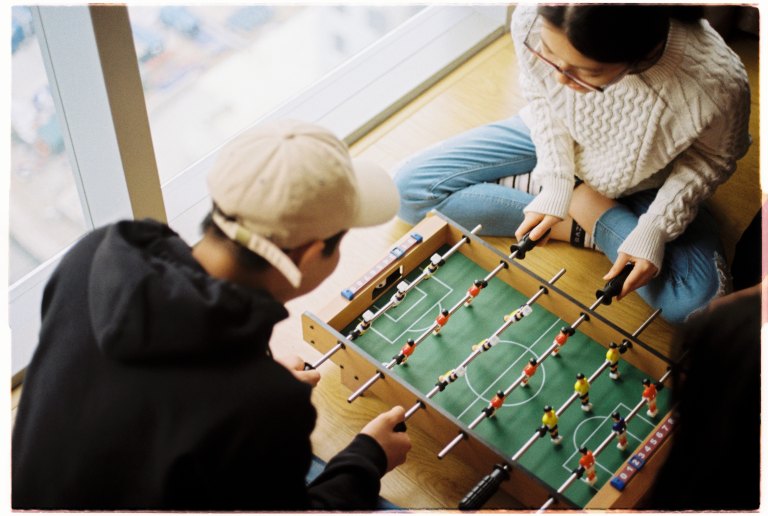
How To Recognize Each Myers-Briggs Personality Type Based On Their Inferior Function

There are many different ways to recognize Myers-Briggs personality types in real life. While an understanding of cognitive functions is crucially important to recognizing others types, it’s also important to factor in the position of those functions in the individual’s stacking.
Once you have a base understanding of how each cognitive function manifests in each position, you can begin to type others based on their most turbulent function – their inferior, or fourth, function.
While the dominant, auxiliary (and to a lesser extent tertiary) function of an individual will give away a great deal about his or her type, the inferior function often highlight’s the greatest insecurity of the type in question.
By watching when an where the following insecurities arise in a given individual, you may be one step closer to accurately determining his or her personality type.
Inferior Si – Resistance to conformity.
ENFPs and ENTPs lead with dominant extroverted intuition – which means that their inferior function is introverted sensing. In the inferior position – prior to maturation – Si manifests as a resistance to ‘settling down’ and obeying the rules of society without thoroughly analyzing those rules for themselves.
ENFPs and ENTPs can often be spotted – particularly when they’re young – by their aversion to conformity and their desire to question absolutely everything before agreeing to or deciding upon any of it. They may seek out nontraditional life paths, openly explore and discuss taboo topics, and generally display a keen interest in going against the grain.
*Note: The Ne-dominant type’s resistance to conformity may look similar to the Se-dominant type’s – but it is based on different reasoning. Whereas the Se-dominant type often resists conformity because they enjoy the constant stimulation of new experiences, the Ne-dominant type is more likely to resist conformity on principle. A quick verbal inquiry as to why each type has been backpacking Asia for the past 20 years is likely to clear up what is driving their unconventional behavior.
Inferior Se – Distrust in their environment.
INFJs and INTJs lead with dominant introverted intuition – which means that their inferior function is extroverted sensing. In the inferior position – prior to maturation – Se manifests as a distrust of one’s physical environment. Because the Ni-dominant type relies so heavily on their intuitive perceptions of what is not immediately apparent, they often fail to trust what is immediately apparent in their environments via their five concrete senses.
Particularly when they are young, the inferior Se-user is likely to over-plan for seemingly simple hands-on tasks. They may print out a map, program a GPS and ask for detailed directions before attempting to navigate somewhere relatively close by. Because they rely more on theoretical reasoning than hands-on input, they may try to reason their way through most physical tasks – I.e. extensively researching how to properly balance on waterskies before they ever strap a pair onto their feet.
Inferior Ti – Resistance to impersonal reasoning.
ENFJs and ESFJs lead with dominant extroverted feeling – which means that their inferior function is introverted thinking. In the inferior position – prior to maturation – Ti manifests as a resistance to impersonal reasoning and a rejection of logic that has the potential to threaten interpersonal peace and/or other’s positive opinion of the Fe-dominant user.
ENFJs and ESFJs can often be spotted – particularly when they’re young – by their tendency to selectively employ logic that paints them in a positive light, and which enables everyone in their environment to get along swimmingly. They are likely to be highly resistant to facts that might disturb the peace in any way, and accuse people who bring up undesirable facts as trying to create conflict for the mere sake of it.
*Note: Inferior introverted thinking may mimic inferior extroverted thinking in that both inferior functions are prone to picking and choosing facts that correspond to their emotional experiences. However, Fe-dominant types are more likely to favor facts that maintain interpersonal harmony and/or maintain others view of them as positive, whereas Fi-dominant types don’t mind rocking the boat or going against the grain if their emotional experience differs from the opinions of those around them (though their cultural environment is likely to influence which beliefs they develop).
*Other note: As with any inferior function, ENFJs and ESFJs are likely to grow into their introverted thinking and use it in a constructive and logical fashion. A mature version of inferior introverted thinking may resemble the ExFJ using unbiased theory as a means of supporting their extroverted feeling – I.e. a counselor researching which therapy techniques have proven to be the most effective. However, the inferior Ti will most often serve to support Fe’s goals, rather than vice versa.
Inferior Te – Resistance to structure.
INFPs and ISFPs lead with dominant introverted feeling – which means their inferior function is extroverted thinking. In the inferior position – prior to maturation – Te manifests as a resistance to structure and organization. Dominant Fi-users are likely to believe, early on in life, that placing limits on their time or energy limits their both creativity and their emotional/intellectual exploration.
As Te-inferior types grow up, they may become frustrated by others failing to take them seriously due to their poor time management skills and may consequently become hyper-rigid about meeting deadlines or reasoning in a black-and-white way. Therefore, Te-inferior types can often be spotted (and differentiated from Ti-dominant types) not just by their tendency to be disorganized, but by their hyper-sensitivity to appearing as such.
Because Fi-users are highly invested in their sense of personal identity, they tend to be the least tolerant of seeing their own flaws in others. Therefore, an Fi-dominant teacher may be the most strict towards students who are late or disorganized – showing them no compassion, since they perceive the world to be showing them no compassion for their own disorganized tendencies.
*Note: Mature Fi-dominant types are certainly able to incorporate extroverted thinking into their lives in a healthy way and become productive and organized individuals. However, doing so is likely to be taxing on their energy level, unlike Te-dominant types who genuinely glean energy from organizing projects and adhering to deadlines.
Inferior Ne – Resistance to uncertainty.
ISTJs and ISFJs lead with dominant introverted sensing – which means their inferior function is extroverted intuition. In the inferior position – prior to maturation – Ne manifests as the tendency to perceive disasters that might arise from not following the rules (or the most common approach to a given situation).
ISTJs and ISFJs can often be spotted – particularly when they are young – by their strict adherence to whichever customs, rules or ideologies they grew up with. As they age, these types are likely to contrast various ideologies they have been exposed to, and determine for themselves which one makes the most sense. However, their inferior Ne is still likely to manifest as a dislike of any ideas or situations that are uncertain or open-ended in nature. Si-dominant types are uncomfortable with a high degree of uncertainty in their lives, and they prefer to take only calculated risks.
Inferior Ni – Resistance to long-term planning.
ESFPs and ESTPs lead with dominant extroverted sensing – which means their inferior function is introverted intuition. In the inferior position – prior to maturation – Ni manifests as a reluctance to narrow down options and create long-term plans.
ESFPs and ESTPs can often be spotted – particularly when they are young – by their open-ended lifestyle. They may speak only vaguely of their plans for the future, preferring to ‘see where things go,’ rather than narrowing down what they want for themselves five or ten years down the line. They may use vague platitudes in place of long-term plans, telling their friends and family members that ‘everything happens for a reason,’ or ‘things always work themselves out in time.’
Inferior Fi – Resistance to vulnerability.
ENTJs and ESTJs lead with dominant extroverted thinking – which means their inferior function is introverted feeling. In the inferior position – prior to maturation – Fi manifests as a reluctance to show or even feel vulnerability. The Te-user may refuse to disclose their feelings to others, and may even refuse to recognize them within themselves.
ENTJs and ESTJs an often be spotted – particularly when they are young – by their desire to seem emotionally impenetrable. They may openly look down on others for making emotion-based decisions and go to great lengths to avoid seeming ‘weak’ to others. Until their inferior function develops, ESTJs and ENTJs may even experience trouble accessing their own emotions – they may be ceaselessly hard on themselves, wanting to believe themselves to be impenetrable to the core. These types spend a great deal of their young lives mastering the art of emotional repression.
Inferior Fe – Resistance to social norms.
INTPs and ISTPs lead with dominant introverted thinking – which means their inferior function is extroverted feeling. In the inferior position – prior to maturation – Fe manifests as a reluctance to entertain social niceties. Ti-dominant types value pursuing reason above keeping the peace, and may grow irritated by those who place a higher value on interpersonal harmony and social conventions than they do on accuracy and truth.
INTPs and ISTPs can often be spotted – particularly when they are young – by their refusal to adhere to social norms. They may routinely dress down, refuse to engage in small talk and fail to show ‘appropriate’ attentiveness or respect to parents, teachers or other authority figures.
On the flip side, as the INTP and ISTP begin growing aware of their extroverted feeling, they may wish to respond appropriately to social situations but feel unsure of how to do so. They may become incredibly nervous that they are saying the wrong thing or behaving inappropriately, as they are not naturally tuned into how those around them are feeling. They may grow visibly nervous when a situation requires an emotional reaction from them and either over or under-react to the emotional demands of the people in their lives. In any case, struggling to understand or adhere to social norms is a key indication of inferior extroverted feeling. ![]()











